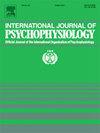Exploring the impact of gentle stroking touch on psychophysiological regulation of inhibitory control
IF 2.5
3区 心理学
Q3 NEUROSCIENCES
引用次数: 0
Abstract
Touch has been shown to regulate emotions, stress responses, and physical pain. However, its impact on cognitive functions, such as inhibitory control, remains relatively understudied. In this experiment, we explored the effects of low-force, slow-moving touch—designed to optimally activate unmyelinated cutaneous low-threshold mechanoreceptor C-tactile (CT) afferents in human hairy skin—on inhibitory control and its psychophysiological correlates using the Stroop Task, a classic paradigm commonly employed to assess inhibitory control capacity. The Stroop Task was repeated twice before and once after receiving either gentle touch or no-touch. Participants were assigned to two groups: the touch group (n = 36), which received low-force, slow-moving touch on their forearms at a stroking velocity of ~3 cm/s, and the no-touch group (n = 36), which did not receive any touch stimulation. Changes in autonomic nervous system activity were also assessed by measuring heart rate variability (HRV) and skin conductance levels before and during cognitive performance. Compared to the no-touch group, participants who received gentle, low-force, slow-moving touch demonstrated faster responses and higher HRV during the Stroop Task. Additionally, within the touch group, individuals with higher HRV exhibited even quicker performance on the cognitive task. While we cannot draw definitive conclusions regarding the CT velocity-specific effect, these results provide preliminary evidence that low-force, slow-moving touch may influence cognitive processes involved in the inhibitory control of goal-irrelevant stimuli.
“探索轻柔抚摸对抑制控制的心理生理调节的影响”。
触摸已被证明可以调节情绪、压力反应和身体疼痛。然而,它对认知功能的影响,如抑制控制,仍然相对缺乏研究。在本实验中,我们利用Stroop任务(一种通常用于评估抑制控制能力的经典范式)探索低力、慢速触摸对抑制控制及其心理生理相关因素的影响,该实验被设计为最佳激活无髓鞘皮肤低阈值机械受体c -触觉(CT)传入。Stroop任务在接受轻柔触摸或不触摸之前重复两次,在接受轻柔触摸或不触摸之后重复一次。参与者被分为两组:触摸组(n = 36),他们的前臂以~3 厘米/秒的抚摸速度接受低强度、缓慢移动的触摸,而不触摸组(n = 36),他们没有接受任何触摸刺激。自主神经系统活动的变化也通过测量心率变异性(HRV)和皮肤电导水平在认知表现之前和期间进行评估。与无触碰组相比,接受温柔、低力度、慢速触碰的参与者在Stroop任务中表现出更快的反应和更高的HRV。此外,在触摸组中,HRV较高的个体在认知任务中表现得更快。虽然我们不能得出关于CT速度特异性效应的明确结论,但这些结果提供了初步证据,证明低力、缓慢移动的触摸可能影响涉及目标无关刺激抑制控制的认知过程。
本文章由计算机程序翻译,如有差异,请以英文原文为准。
求助全文
约1分钟内获得全文
求助全文
来源期刊
CiteScore
5.40
自引率
10.00%
发文量
177
审稿时长
3-8 weeks
期刊介绍:
The International Journal of Psychophysiology is the official journal of the International Organization of Psychophysiology, and provides a respected forum for the publication of high quality original contributions on all aspects of psychophysiology. The journal is interdisciplinary and aims to integrate the neurosciences and behavioral sciences. Empirical, theoretical, and review articles are encouraged in the following areas:
• Cerebral psychophysiology: including functional brain mapping and neuroimaging with Event-Related Potentials (ERPs), Positron Emission Tomography (PET), Functional Magnetic Resonance Imaging (fMRI) and Electroencephalographic studies.
• Autonomic functions: including bilateral electrodermal activity, pupillometry and blood volume changes.
• Cardiovascular Psychophysiology:including studies of blood pressure, cardiac functioning and respiration.
• Somatic psychophysiology: including muscle activity, eye movements and eye blinks.

 求助内容:
求助内容: 应助结果提醒方式:
应助结果提醒方式:


